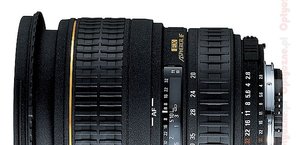Waterproof cameras test 2012 - part I
3. Fujifilm FinePix XP50
 |
The Fujifilm FinePix XP50 was presented at the beginning of this year during CES fairs. It is the successor of the XP30 model, tested by us last year, or, in fact rather the XP20 because that one, like the XP50, featured a GPS module. Small wonder the new FinePix has inherited a lot from its older brother. You can find here the same lens with the equivalent of 28-140 mm focal lengths and a f/3.9-4.9 aperture; also an LCD screen is identical, with a diagonal amounting to 2.7 inches and the resolution of 230,000 screen dots. The outer casing looks a bit different (it is a bit thicker and heavier) but its waterproof and shockproof qualities remain the same. The camera is submersible up to 5 meters and is shock proof to a height of 1.5 meters.
Still there are some new features in the XP50. First of all the producer used a CMOS-type sensor, not a CCD one. Its resolution didn’t change but that operation allowed to extend the movie recording mode so the camera allows you to capture Full HD 1920×1080 movies at 30 fps. The next novelty is the Motion Panorama mode, known from more expensive models – it allows you to take panoramic photos by just pressing the shutter release and move the camera to the right direction. The list is closed by a HDMI output which was finally included in this underwater version of the Fuji camera.
Here we can in fact end the comparison between the new and the old model and progress to the proper test. Let’s find out what the constructors achieved giving the SP50 a new sensor.
Please Support UsIf you enjoy our reviews and articles, and you want us to continue our work please, support our website by donating through PayPal. The funds are going to be used for paying our editorial team, renting servers, and equipping our testing studio; only that way we will be able to continue providing you interesting content for free. |
- - - - - - - - - - - - - - - - - - - - - - - - - - - - - - - - - - - - - - - - - - - - - - - -
Design and build quality
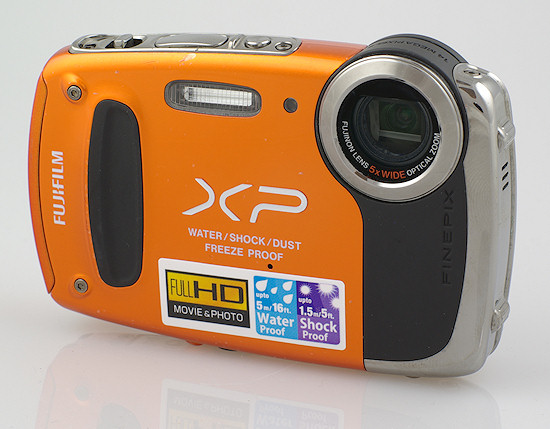 |
The FinePix XP50 is not as solidly build as its older brother – all because of its front panel which was made of plastics covered by a coat of shiny varnish, not of aluminum. That’s why the body is no longer so rigid and it creaks slightly when pressed. On the side panel, covering a little loudspeaker, you can find a part made of hard, quite slippery plastic, known from the XP30 but the rest of the construction (the back panel and the other side) is made of soft or rubberized plastic, known from the older model. Along with a thumb inset and an appropriate perforation you get a camera which is easy and comfortable to handle.
The designers decided to modify a bit sealed covers, situated on the side panel of the XP30 and so criticized by us previously. In the new model there is just one comfortable cover with a block under which you can find a storage battery NP-45A b a memory card slot (SD/SDHC/SDXC), an USB 2.0 Hi-speed port and a micro HDMI output.
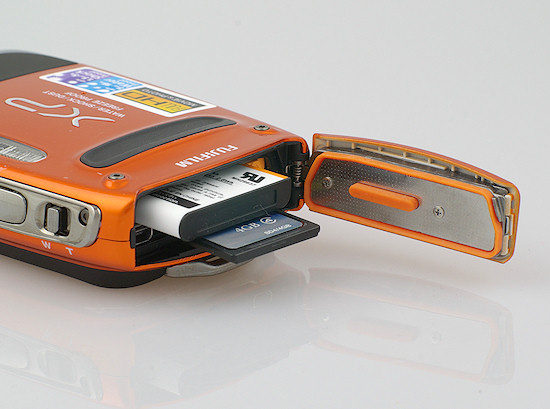 |
Although you can open the cover very comfortably all elements underneath are rather deep inside, like it was in the case of the XP30. It is not a big problem when it comes to the USB port but people with sturdy fingers or/and short fingernails might have a lot of problems with taking out the battery or the memory card. It is a standard procedure to push the memory card a bit in before pulling it out – some users might find it an impossible task here, at least without using an additional tool.
There is no change in the layout of the buttons so on the upper panel you can find an on/off switch, a shutter release and a zoom lever.
 |
On the back there is a thumb inset and a movie recording button right beside it. Below you see a MENU/OK button surrounded by a four-way controller which additionally gives you a speedy access to the macro mode settings, exposition compensation, delayed-action release and a flash. At the very bottom you can also find a switch starting the playback mode and a DISP/BACK button, making you return to the previous menu level and change information displayed on the LCD screen.
At the end of this section we should mention also a tripod socket, situated almost in the middle of the bottom panel.
Use, cleaning, wear and tear
Our editorial office was sent a complete new specimen of the tested camera. After a week of tests in Egypt we noticed some tiny scratches, The front panel suffered the most – you could see several bigger scratches there. The varnish should be praised though – it didn’t chip off and any flaws you can find there are really slight. The situation is worse in the case of the LCD screen – it became scratched after its first landing on the sand. The scratches were superficial but their number is huge and it certainly doesn’t make framing in bright light easier. That fact surprises us a bit – as far as I remember we didn’t complain about the quality of the LCD screen protector of the XP30.The cleaning of the XP50 is not problematic at all. The casing is smooth and devoid of nooks and crannies so there is no good place where salt can be deposited. In this category the Fuji can be considered an example to follow. Unfortunately the usage of the back panel from the previous model resulted in the same affliction we described a year ago. Even two days after the diving, when the camera seems to be perfectly dry, it’s enough you press any buttons and water is coming from under the back panel. These are just isolated droplets but they certainly don’t add to the comfort of operating that device.
Additional functions
There is no GPS receiver in the tested model – that feature went to the more expensive XP150 devicel. Still the XP50 features a fully-fledged panoramic photo mode. To shoot a panorama it’s enough to press the shutter release and move the camera to the right direction. Additionally you can determine what angle the panoramic shot should include: 120, 180 or 360 degrees. Choosing the last option, however, you must be aware that you won’t be able to make a full turn and the camera, encountering a more difficult fragment to analyze, can stop the shooting process. In the case of 120 and 180 degrees panoramas there are no such problems. Looking at the panoramic photos it is clear the Fuji performs a bit worse than the Panasonic FT4. 120 deg. panorama . Click to enlarge. |
 180 deg. panorama . Click to enlarge. |
360 deg. panorama . Click to enlarge. |
Waterproofness
According to the specifications the Fujifilm FinePix XP50 is waterproof up to 5 m and when you exceed that depth you start having problems with taking photos. The water pressure starts squeezing the buttons, the shutter release included, and makes the whole camera completely unresponsive. The maximum depth at which we managed to take a photo was not much more than 6 m – it this category the XP50 occupies the last place.
Underwater usage
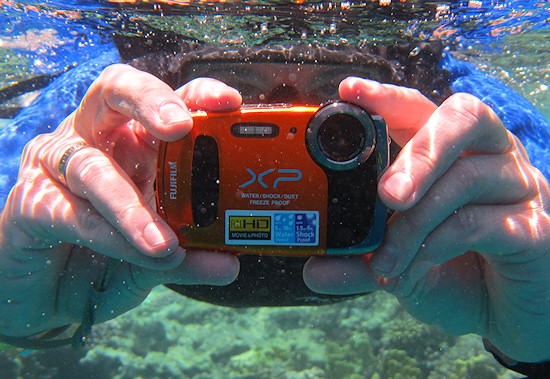 |
The construction of the FinePix XP50 menu is the same as in the older models so if you want to start the underwater mode you must browse through a long, vertical list of different thematic modes.
 |
 |
Like in the XP30, there are three thematic underwater modes in the new model:
- Underwater – for underwater photos,
- Underwater (width) – for underwater photos which include more background behind the photographed object,
- Underwater (macro) – for underwater close-ups of small objects.
 |
In the new model we didn’t notice those random exposure problems we described in the last year’s test which is certainly the tested Fuji’s advantage. Unfortunately the autofocus cannot be described in similar terms – like in the older model it is slow and far from accurate. You get many more or less blurred photos and sometimes the camera simply fails to focus and you get just a completely blurry shot.
The casing of the XP50 is small and slippery – you can forget about a firm grip under water. A wrist strap with a clip helps you not to lose the camera, though.
 |
At the end some words about the LCD screen. It is just 2.7 inches big with only 230,000-dot resolution so in bright sunlight the images are practically invisible. Additional problems can be created by slight scratches which appear quickly on the surface of the screen protecting window.
Underwater photos and movies quality
 |
The quality of underwater photos, taken by the XP50, doesn’t bowl you over. The weak autofocus makes itself felt in many circumstances and the specific exposure means the images are almost always underexposed; joined with weak colouring it makes them dark and gloomy. As a result they hardly reflect the sights you can admire in warm, colourful Mediterranean waters. As it wasn’t enough, the white balance likes playing tricks as well – when you press the shutter release you never know what kind of image the FinePix will produce this time. The examples below show it pretty well – we present two photos of the same frame, taken one right after the other with the same settings.
 |
 |
 |
 |
When you take a photo against bright light the situation is even worse. It loses much of its clarity, its contrast declines and it seems we are looking at things through a blanket of fog. When you add to it the fact that in such a case the colouring can be even worse it turns out some photographs look as if they were taken in cold, murky waters of a Polish lake, not in a crystal-clear sea.
At greater depths the situation doesn’t improve at all. We must tackle weak colouring and poor detail rendering; the closer to the frame edge you get, the worse it is.
The macro mode is not impressive either. As the reproduction scale is not bad, because you can come pretty close to the photographed object, the weak autofocus makes itself felt once again. It doesn’t perform well in normal scenes but in macro photography it simply capitulates because the depth of field is much more shallow. That’s why most of attempts of taking a macro shot end up as fuzzy photographs on the memory card.
In green waters the colouring doesn’t lag behind the performance of the competitors but the detail rendering is worse. Once again the weak AF is to blame; it fares even worse in murky water with less light. As a result out of more than a dozen trials only in three cases the camera confirmed the focus and took shots which proved to be fuzzy anyway.
 Click to enlarge. |
Luckily the quality of underwater movies is not so bad. Their colouring is definitely better than that of the photos and the light measurement works properly so they aren’t underexposed. You can notice a slight blue-green dominant but it is not as strong as in the case of the Olympus an the colours are more saturated than in the FT4. As a result video clips from the XP50 are nice to watch, especially as, when it comes to the detail rendering, they represent a higher level than that of the Panasonic FT4, being closer to the results of the Olypmus TG-820. Unfortunately the performance is a bit worse than that of the Canon. The camera deals decently with shots against bright light – there is no pink cast which so often appears in such situations. Floating on quite big waves, we didn’t notice bigger problems with focusing. At a depth of 3-5 meters you must take into account the fact that your movies might have worse colouring – the blue cast makes itself felt rather keenly there.
Summary
First, take a look at the list of pros and cons of the tested camera.
-
Pros:
- Satisfying colouring of underwater movies,
- Good detail rendering in underwater movies,
- Correct colouring of photos on dry land in the underwater mode,
- Functional strap added in the box,
- Panoramic photos mode,
- Comfortable zoom slider,
- Easy to clean.
- Waterproof only to a depth of 6 m,
- Not very legible LCD screen against bright light,
- LCD screen prone to scratches,
- Low resolution of the LCD screen,
- Scene modes hidden deep in the menu,
- Very slow and not accurate autofocus,
- Slow focusing after focal length change in video mode,
- Underwater photos not very detailed,
- Not very vivid colouring of pictures and underwater movies,
- Pictures and movies recorded at greater depth with strong blue dominant,
- Exposure problems,
- Problems with underwater white balance,
- Small and slippery casing.
Cons:
The Fuji is traditionally the cheapest camera in our test – for the XP50 currently you have to pay about 670 PLN. The Canon and the Panasonic are two times as expensive and the Olympus costs half more. You can’t ignore this fact when assessing the new FinePix. However, even considering the low price tag, you can’t forget the autofocus and underwater white balance problems, described above. The quality of underwater pictures also leaves a lot to be desired – the change of the sensor didn’t help here. Fortunately the Fujifilm constructors have applied themselves to the improvement of the movie recording mode so in this particular category the camera doesn’t have to be ashamed of its performance; the Motion Panorama mode is also a nice addition.
Buing the XP50 you must be aware that, paying less than 700 PLN you get a camera waterproof only up to a depth of 6 metres which won’t delight you with the high image quality. The tested Fuji should be treated as a cheap, holiday addition to our snorkel pipe and a diving mask, not something that might meet expectations of divers.
Sample underwater movies
| H.264 MOV, 1920×1080 pix, 30 kl/s, 11 s, 20.8 MB |
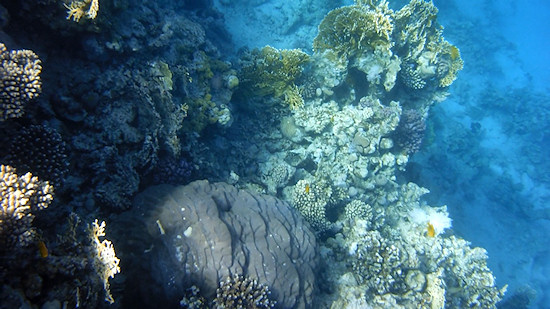 |
| H.264 MOV, 1920×1080 pix, 30 kl/s, 15 s, 28.5 MB |
 |
| H.264 MOV, 1920×1080 pix, 30 kl/s, 13 s, 24.2 MB |
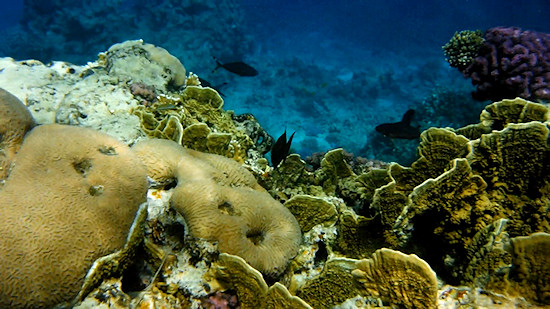 |
| H.264 MOV, 1920×1080 pix, 30 kl/s, 16 s, 31.2 MB |
 |
Sample underwater photos






























